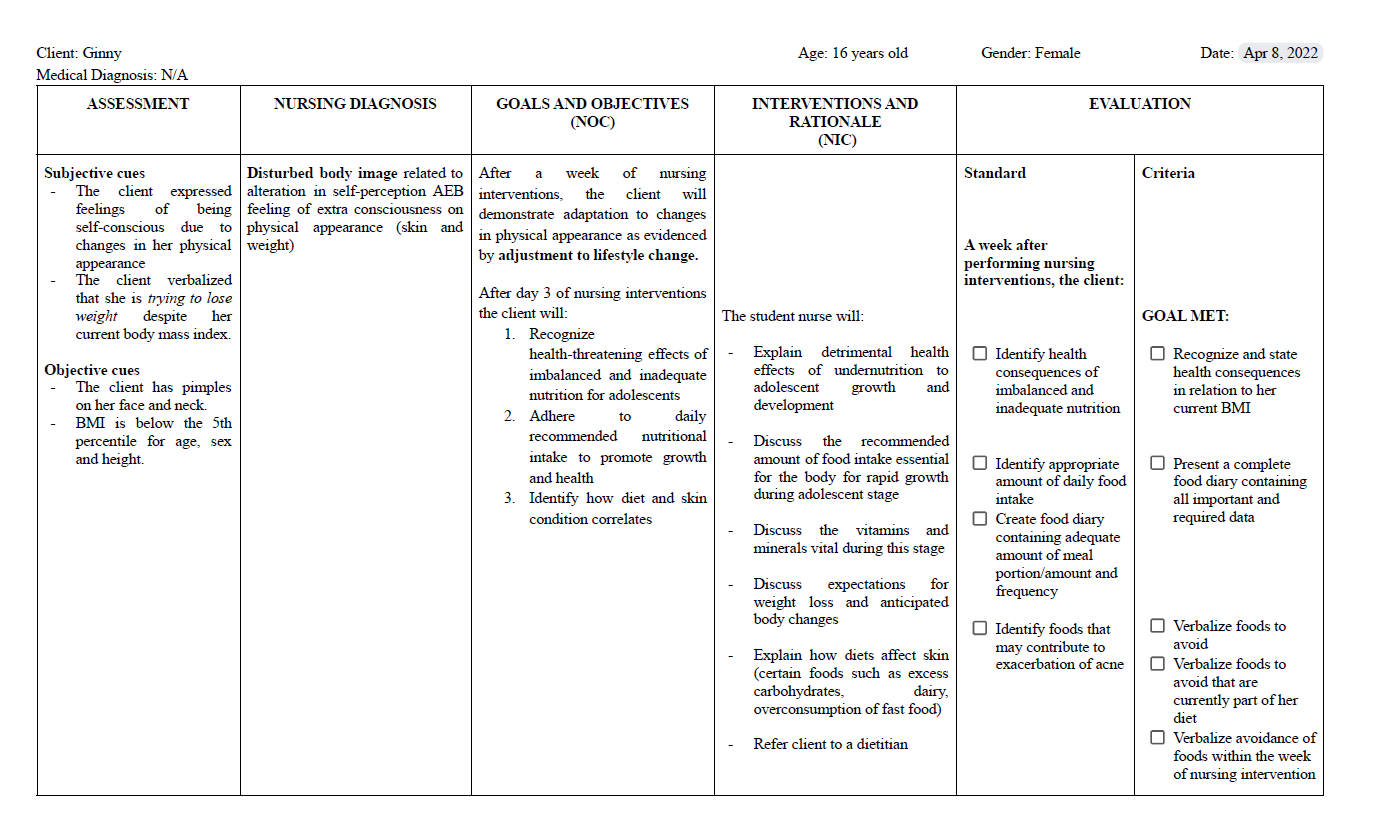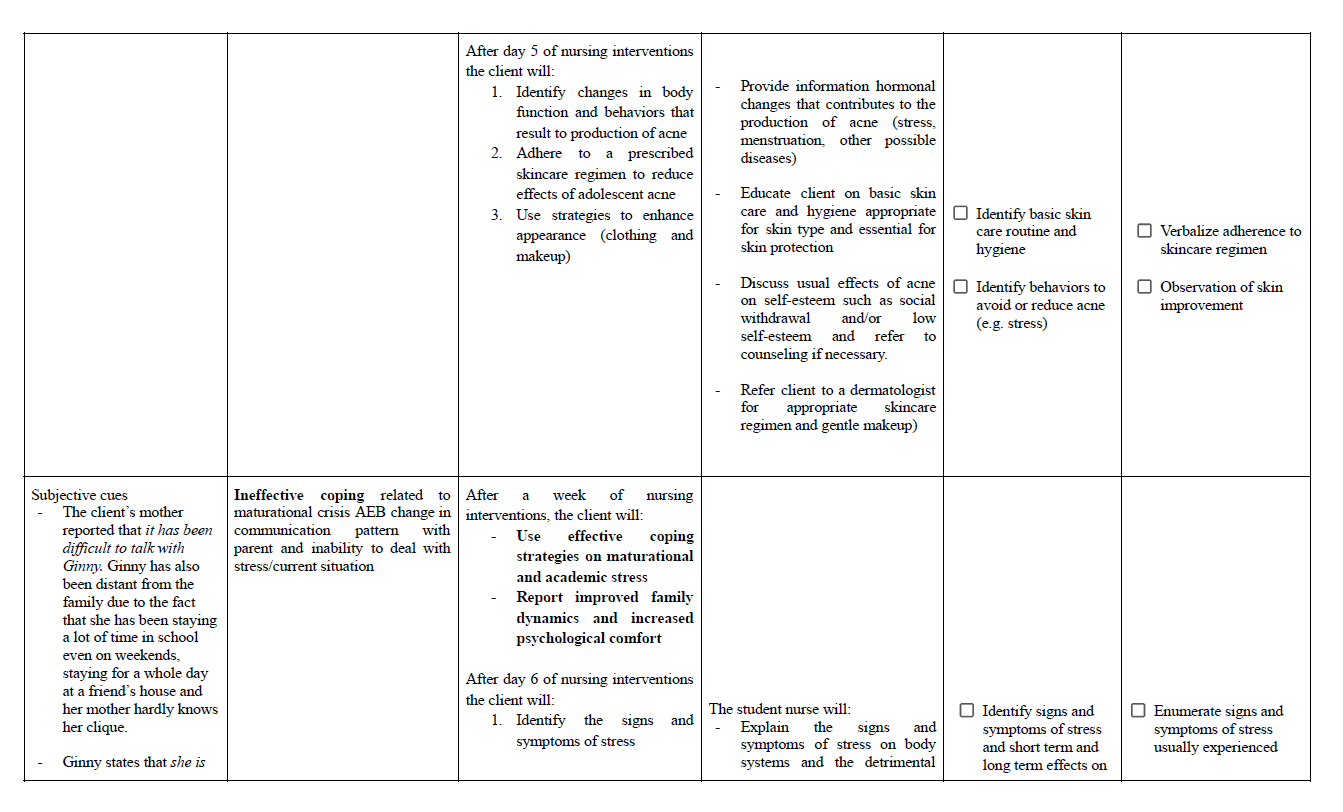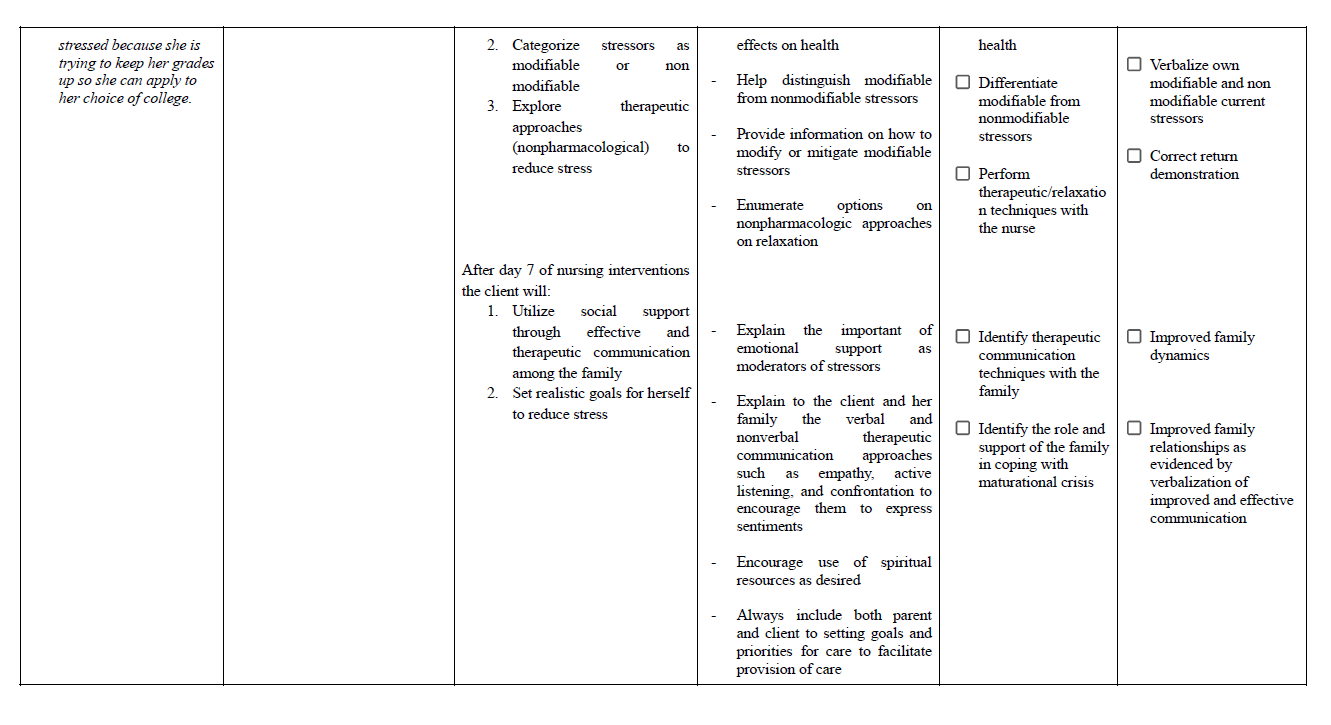


References:
Berman, A., Snyder, S., & Frandsen, G. (2016). Kozier & Erb’s Fundamentals of Nursing: Concepts, Process, and Practice. 10th ed. Upper Saddle River, New Jersey: Pearson Education, Inc.
Aldaba, J. (2022). Care of the Child from Infancy to Adolescence: Care of the Adolescent [PowerPoint Slides]. University of the Philippines Manila Virtual Learning Environment: https://vle.upm.edu.ph/login/index.php
| Problems Identified | Rationale | Goals of Care | Interventions |
| Disturbed body image related to alteration in self-perception AEB feeling of extra consciousness on physical appearance (skin and weight) | According to a study by Tasoula et. al (2012), teens with acne showed that feelings of unworthiness due to negative appraisal by peers is evident in this population. The severity of acne proportionally impacts their self-perception hence developing a sense of disturbed body image. This is considered diagnosis due to the present cues supporting the validity of the problem. | Please refer to the NCP above | Please refer to the NCP above |
| Ineffective coping related to maturational crisis AEB change in communication pattern with parent and inability to deal with stress/current situation | This problem has been selected as a problem due to the mother’s report of her child being distant due to facing maturational crisis. Adolescence is a period of change and coping mechanisms may be unhealthy if the adolescent is not properly supported. In this stage, the client needs a supportive environment that fosters active, empathic listening and values communication. Adolescents is also a period of risk taking hence, proper guidance should be provided with assistance from the parents and counselors. This diagnosis targets both client and family hence, can provide a holistic solution to the family. | Please refer to the NCP above | Please refer to the NCP above |
| Imbalanced nutrition: less than body requirements related to insufficient dietary intake AEB verbalization of “trying to lose weight” and BMI below the 5th percentile for age, sex and height. | The client has a BMI below the 5th percentile for age, sex and height and is an indicator it may hinder proper growth and development. Dieting is popular among adolescent girls to fit into societal standards of attractiveness and can lead to eating disorders. This problem should be addressed as early as possible to avoid leading to psychological manifestations. |
The client will: - progressively gain weight as evidenced by 0.5 lbs. per week - identify nutritional requirements for adolescents Recognize eating behaviors that contribute to being underweight |
The student nurse will: - Educate client on appropriate weight for adolescents and how to achieve weight gain - Explain how to create a meal plan that will aid growth and development Create healthy meal plan that promotes healthy food choices and high satiety |
| Anticipated Problems | Rationale |
| Situational low self-esteem related to alteration in body image AEB feeling extra conscious of her looks due to presence of pimples on face and neck | The client has expressed feelings of extra consciousness due to her appearance, hence it will soon affect her self-esteem and may lead to unhealthy coping mechanisms. Depression and social isolation may also be the results of low-self-esteem. According to Raty and Gustafsson (2006), validation of emotions is related to a client’s experience of caring, this signifies that emotional help and validation from nursing interventions can impact the client’s self-perception and self-esteem. |
| Ineffective adolescent eating dynamics related to changes to self-esteem and excessive stress AEB verbalization of ‘trying to lose weight’ and experienced academic-related stress | Since the client has expressed concerns related to self-image, this problem can soon manifest. Ineffective adolescent eating dynamics can be a precipitating factor to eating disorders that is currently prevalent among adolescents. |
| Stress overload related to academic and personal stressors AEB verbalization of experienced stress | It is common knowledge that stress alters our physical and cognitive function hence affects our health, well-being, and performance. It is important to address this problem once the client has insufficient resources to cope or reduce the amount of stress by teaching healthy coping mechanisms as stated above (ineffective coping). A more focused nursing intervention on stress reduction shall be provided once problem occurs or intensifies. |
Health Education Plan
Nutrition Education to Improve Nutritional Status and Increase Body Weight
Target Audience: Ginny and Jennifer
Objectives:
- State the importance of eating appropriate food portion sizes
- Identify at least 3 dietary strategies to increase satiety with healthy options
- State the procedures on how to utilize a food diary
Content
1a. Demonstrate how to get variables for nutrient analysis such as:
- Desired body weight
- Total Energy Allowance
- Percentage distribution of carbohydrates, protein and fats in TEA
1b. Discuss rationales behind nutrient analysis variables
1c. Explain importance of nutrient analysis in determining proper food proportions
2a. Explain the role of satiety as precursor to achieving a successful dietary regimen
2b: Discuss food groups that yield high satiety such as:
- Protein
- Dietary Fiber
- Fruits and Vegetables
2c. Discuss the beneficial effects of slow-paced eating
2d. Discuss how visual cues of portion sizes may influence intake
3a. Explain the importance of self-monitoring through food diary
3b. Explain the frequency of input in food diary
3c. Describe what type of information should be written in a food diary
- Food
- Time of meal
- Portion sizes (estimated)
- Place when eating meals
- Mood when eating
3d. Present a sample format of a food diary
Method of Instruction
1. One-to-one discussion & Demonstration
2. One-to-one discussion
3. One-to-one discussion & printed material
Method of Evaluation
1. Verbalization of the importance of adhering to appropriate food portion sizes
2. Question and Answer
3. Verbalize steps on how to utilize food diary
Tasoula, E., Gregoriou, S., Chalikias, J., et al. (2012). The impact of acne vulgaris on quality of life and psychic health in young adolescents in Greece. Results of a population survey. Anais Brasileiros de Dermatologia, 87(6), 862–869.
Raty, L., & Gustafsson, B. (2006). Emotions in relation to healthcare encounters affecting self-esteem. The Journal of Neuroscience Nursing: Journal of the American Association of Neuroscience Nurses, 38(1),
Department of Science and technology & Food and Nutrition Research Institute. (1994). Food exchange lists for meal planning (3rd revision ed.). FNRI Publication No. 57-ND
Rebello, C. J., Liu, A. G., Greenway, F. L., & Dhurandhar, N. V. (2013). Dietary Strategies to Increase Satiety. Advances in Food and Nutrition Research, 105–182. https://doi.org/10.1016/b978-0-12-410540-9.00003-x
Angelopoulos, T., Kokkinos, A., Liaskos, C., Tentolouris, N., Alexiadou, K., Miras, A. D., Mourouzis, I., Perrea, D., Pantos, C., Katsilambros, N., Bloom, S. R., & le Roux, C. W. (2014). The effect of slow spaced eating on hunger and satiety in overweight and obese patients with type 2 diabetes mellitus. BMJ Open Diabetes Research & Care, 2(1), e000013. https://doi.org/10.1136/bmjdrc-2013-000013
Wansink, B., Painter, J. E., & North, J. (2005). Bottomless Bowls: Why Visual Cues of Portion Size May Influence Intake**. Obesity Research, 13(1), 93–100. https://doi.org/10.1038/oby.2005.12
McManus, K. D. (2019, January 31). Why keep a food diary? - Harvard Health. Harvard Health; Harvard Health. https://www.health.harvard.edu/blog/why-keep-a-food-diary-2019013115855#:~:text=Research%20shows%20that%20for%20people,those%20who%20kept%20no%20records.
I apologize for the late submission Prof. Aldaba. I was not able to read through the rubrics hence I was not able to include a health education plan. I deeply apologize, I hope my work will still be considered.
Tasoula, E., Gregoriou, S., Chalikias, J., et al. (2012). The impact of acne vulgaris on quality of life and psychic health in young adolescents in Greece. Results of a population survey. Anais Brasileiros de Dermatologia, 87(6), 862–869.
Raty, L., & Gustafsson, B. (2006). Emotions in relation to healthcare encounters affecting self-esteem. The Journal of Neuroscience Nursing: Journal of the American Association of Neuroscience Nurses, 38(1),
Department of Science and technology & Food and Nutrition Research Institute. (1994). Food exchange lists for meal planning (3rd revision ed.). FNRI Publication No. 57-ND
Rebello, C. J., Liu, A. G., Greenway, F. L., & Dhurandhar, N. V. (2013). Dietary Strategies to Increase Satiety. Advances in Food and Nutrition Research, 105–182. https://doi.org/10.1016/b978-0-12-410540-9.00003-x
Angelopoulos, T., Kokkinos, A., Liaskos, C., Tentolouris, N., Alexiadou, K., Miras, A. D., Mourouzis, I., Perrea, D., Pantos, C., Katsilambros, N., Bloom, S. R., & le Roux, C. W. (2014). The effect of slow spaced eating on hunger and satiety in overweight and obese patients with type 2 diabetes mellitus. BMJ Open Diabetes Research & Care, 2(1), e000013. https://doi.org/10.1136/bmjdrc-2013-000013
Wansink, B., Painter, J. E., & North, J. (2005). Bottomless Bowls: Why Visual Cues of Portion Size May Influence Intake**. Obesity Research, 13(1), 93–100. https://doi.org/10.1038/oby.2005.12
McManus, K. D. (2019, January 31). Why keep a food diary? - Harvard Health. Harvard Health; Harvard Health. https://www.health.harvard.edu/blog/why-keep-a-food-diary-2019013115855#:~:text=Research%20shows%20that%20for%20people,those%20who%20kept%20no%20records.
I apologize for the late submission Prof. Aldaba. I was not able to read through the rubrics hence I was not able to include a health education plan. I deeply apologize, I hope my work will still be considered.